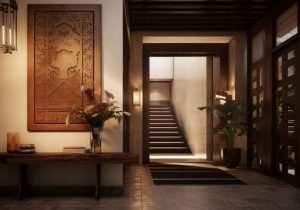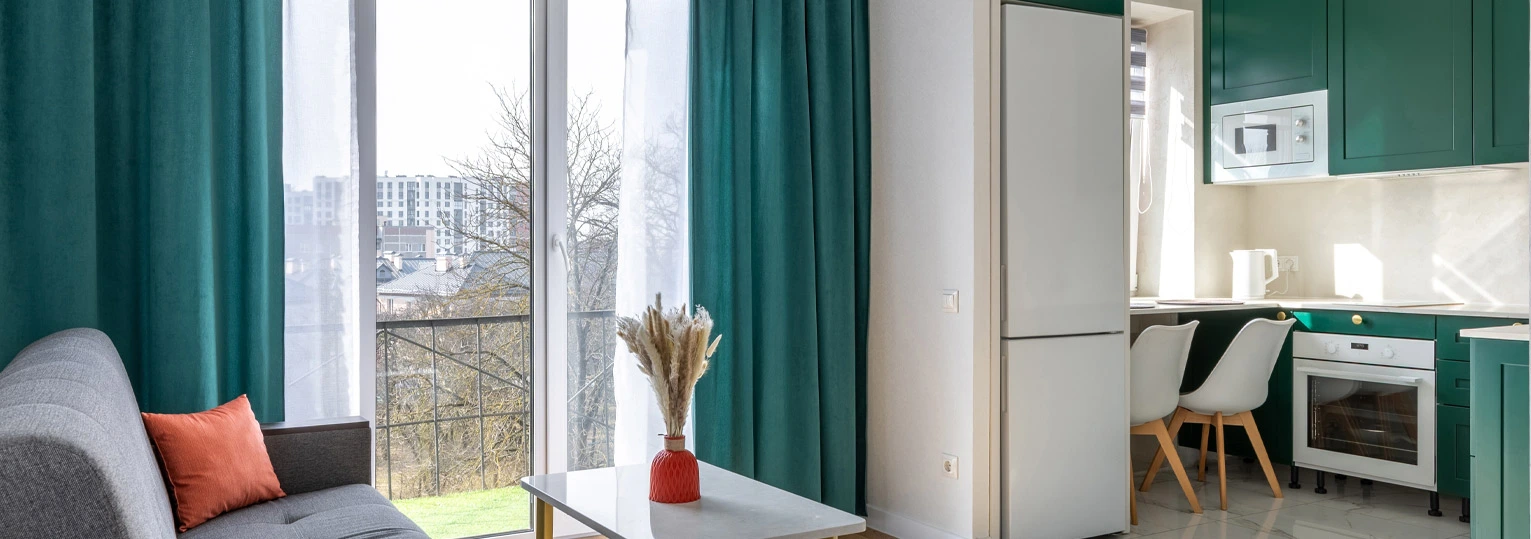In a bustling neighbourhood of Mumbai, there’s a house that always seems to have an air of calmness around it. This house belongs to Mr. Mehta, a man known for his great taste in design. As you step into his home, the first thing that catches your eye is the stylish foyer. It’s not just an entryway but a statement of style and peace. The sleek hardwood flooring shines softly under the gentle lights, and a simple bench sits gracefully against the wall, inviting guests to sit and pause for a moment. The simplicity and elegance of stylish foyer set the tone for the rest of the house, leaving a lasting impression.
The Mehtas recently decided to renovate their foyer, aiming for a modern, minimalist look that would offer both beauty and functionality. They chose high-quality hardwood flooring to replace the old tiles, selecting a neutral tone to match their existing decor.
To complete the transformation, they added a simple yet stylish bench, which not only served as a seating area but also provided hidden storage. The result was a foyer that felt calm and sophisticated, perfectly reflecting the minimalist style.
This renovation shows how combining sleek hardwood flooring with minimalist design can create a welcoming and stylish foyer. Hardwood flooring adds warmth and character to any space, while a thoughtfully chosen bench can provide both comfort and practicality.
Together, these elements can turn a simple entryway into a striking introduction to your home. In this blog, we will explore different hardwood flooring options, bench styles, and design tips to help you create a modern and minimalist foyer that will leave a lasting impression on your guests.

Hardwood flooring has long been a favorite for homeowners due to its durability, timeless appeal, and versatility. Its natural beauty can enhance any decor style, from traditional to contemporary. Unlike other flooring options, hardwood can be refinished multiple times, making it a long-term investment that can adapt to changing tastes and trends.
For the environmentally conscious, there are numerous eco-friendly hardwood options available. Look for flooring certified by the Forest Stewardship Council (FSC) or the Sustainable Forestry Initiative (SFI), which ensures that the wood is harvested responsibly. Bamboo and reclaimed wood are also excellent sustainable choices that offer unique aesthetic qualities.
One of the greatest strengths of hardwood flooring is its versatility. It comes in a variety of wood species, colors, and finishes, allowing you to tailor it to your specific design vision. Whether you prefer the rich, dark tones of walnut or the light, airy feel of oak, there is a hardwood option that will perfectly suit your home.

Neutral-colored hardwood floors are a staple in modern interior design. Shades of gray, beige, and light brown provide a sophisticated backdrop that can make a space feel more open and airy. These colors also complement a wide range of furnishings and decor, making them a flexible choice for any home.
Matte finishes have become increasingly popular for their understated elegance and contemporary look. Unlike high-gloss finishes, matte floors don’t show scratches and scuffs as easily, making them ideal for high-traffic areas with stylish foyers. They also lend a more natural, organic feel to space.
Using the same hardwood flooring throughout your home creates a seamless transition from one room to another, enhancing the sense of continuity and flow. This approach is particularly effective in open-concept designs, where it helps to visually unite different areas into a cohesive whole.
Clean Lines and Simple Forms:
The hallmark of minimalist design is simplicity. Look for benches with clean lines and straightforward forms. Avoid ornate details and focus on sleek, geometric shapes that exude modernity and clarity.
Incorporate benches made from innovative materials like bamboo, metal, or eco-friendly composites. These materials not only add a contemporary touch but also offer durability and easy maintenance.
Choose benches with built-in storage to maximize functionality in your stylish foyer. Hidden compartments and drawers can help keep the area tidy by providing a place to store shoes, bags, and other items that tend to accumulate near the entrance.

Embrace the minimalist ethos by keeping your foyer uncluttered and focused on a few key pieces. This approach not only looks elegant but also creates a calming environment that welcomes you home.
Add a single piece of artwork or a sleek mirror to enhance the space without overwhelming it. These elements can add personality and visual interest while maintaining the simplicity of the design.
Incorporate practical decor items like a stylish coat rack or a sleek umbrella stand. These functional pieces can enhance the overall look of your stylish foyer while providing necessary utility.
For those who enjoy hands-on projects, installing hardwood flooring can be a rewarding DIY endeavor. Ensure you have the right tools and follow step-by-step guides to achieve a professional finish. Remember to acclimate the wood to your home’s humidity and temperature before installation.
Whether you choose to build your own bench or purchase one, pay attention to quality and durability. If you opt for a DIY project, use sturdy materials and follow detailed plans to ensure the bench is both functional and stylish.
Keep your stylish foyer looking its best by regularly decluttering and maintaining the hardwood floors and bench. Simple habits like wiping down surfaces and organizing storage can go a long way in preserving the minimalist aesthetic.

At Bonito Designs, we understand that the foyer is more than just an entryway; it’s the first impression of your home and a reflection of your personal style. Our expertise in creating modern and minimalist spaces ensures that your foyer will be both welcoming and stylish, setting the tone for the rest of your home.
Creating a cozy and stylish foyer with hardwood flooring and a minimalist bench is not just about aesthetics; it’s about combining beauty with functionality. Bonito Designs offers end-to-end solutions to help you achieve this balance. Our team of over 300 talented designers is dedicated to transforming your vision into reality. We work closely with you to select the perfect materials and designs that reflect your unique style.
Quality is at the heart of everything we do. Each project undergoes seven quality checks and over 400 tests to ensure the highest standards are met. Our commitment to timely delivery means you can enjoy your beautifully designed stylish foyer in just 90 days. With in-house manufacturing, every element is built from scratch, ensuring precision and excellence.
Bonito Designs is proud to be the first-ever ISO certified brand in interior design, a testament to our dedication to quality and excellence. We also offer easy EMI options, making it easier for you to achieve the home of your dreams without financial stress.
Whether you’re inspired by DIY projects or seeking professional expertise, Bonito Designs is here to bring your vision to life. Our branded home interior services guarantee that your home is not just decorated, but thoughtfully designed to reflect your unique style and needs. Contact us today to start your journey towards a home that is both beautiful and functional.
By choosing Bonito Designs, you are not just investing in your home; you are investing in a lifestyle that values quality, creativity, and personalization.



